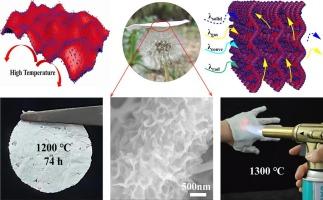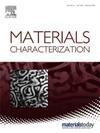Thermally insulating flexible ceramic film based on nanowire-nanosheet dual component synergistic structure with high temperature resistance at 1300 °C
IF 4.8
2区 材料科学
Q1 MATERIALS SCIENCE, CHARACTERIZATION & TESTING
引用次数: 0
Abstract
Nanoscale ceramic films have extensive application prospects in the fields of harsh environments because of their low thermal conductivity, excellent high temperature resistance and fire-retardant. However, the practical application of ceramic film materials is always constrained by structural collapse under prolonged high temperature treatment. Herein, silicon nitride nanowire‑calcium phosphate nanosheet (SiNNW/CHNT) film with synergistic structure is synthesized, where CHNT provides the high temperature protective layer and SiNNW endows the stable skeleton structure. Benefiting from the unique synergistic effect between SiNNW and CHNT, SiNNW/CHNT film demonstrates excellent stability and thermal insulation in high temperature environment. SiNNW/CHNT film exhibits superior high temperature stability, without significant dimensional change even after treated at 1200 °C for 74 h. Additionally, when a human hand is covered with SiNNW/CHNT thermal insulating gloves, it is not feel heat sensing under the butane blowtorch (1300 °C). This research might open up a new strategy for the fabrication of dual-component film with superior thermal structural stability and thermal protection efficiency.

基于纳米线-纳米片双组分协同结构的隔热柔性陶瓷膜,具有 1300 °C 的耐高温性能
纳米级陶瓷膜具有低导热性、优异的耐高温性和阻燃性,因此在恶劣环境领域具有广泛的应用前景。然而,陶瓷膜材料的实际应用总是受到长时间高温处理下结构坍塌的制约。本文合成了具有协同结构的氮化硅纳米线-磷酸钙纳米片(SiNNW/CHNT)薄膜,其中 CHNT 提供高温保护层,SiNNW 赋予稳定的骨架结构。得益于 SiNNW 和 CHNT 之间独特的协同效应,SiNNW/CHNT 薄膜在高温环境中表现出优异的稳定性和隔热性。此外,当人手戴上 SiNNW/CHNT 隔热手套时,在丁烷喷灯(1300 ℃)下也不会有热感。这项研究为制备具有优异热结构稳定性和热保护效率的双组分薄膜开辟了一条新途径。
本文章由计算机程序翻译,如有差异,请以英文原文为准。
求助全文
约1分钟内获得全文
求助全文
来源期刊

Materials Characterization
工程技术-材料科学:表征与测试
CiteScore
7.60
自引率
8.50%
发文量
746
审稿时长
36 days
期刊介绍:
Materials Characterization features original articles and state-of-the-art reviews on theoretical and practical aspects of the structure and behaviour of materials.
The Journal focuses on all characterization techniques, including all forms of microscopy (light, electron, acoustic, etc.,) and analysis (especially microanalysis and surface analytical techniques). Developments in both this wide range of techniques and their application to the quantification of the microstructure of materials are essential facets of the Journal.
The Journal provides the Materials Scientist/Engineer with up-to-date information on many types of materials with an underlying theme of explaining the behavior of materials using novel approaches. Materials covered by the journal include:
Metals & Alloys
Ceramics
Nanomaterials
Biomedical materials
Optical materials
Composites
Natural Materials.
 求助内容:
求助内容: 应助结果提醒方式:
应助结果提醒方式:


